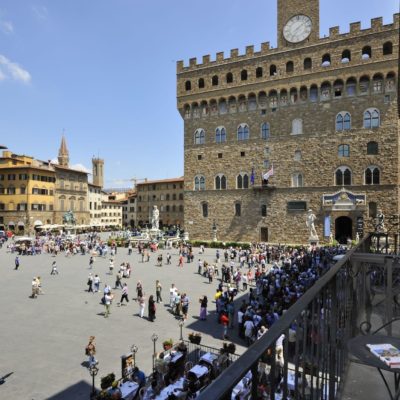Piazza della Signoria is one of the main squares in the historic center of Florence, and one of the most famous and beautiful squares in Italy. Its name comes from the Signoria, that was the government of the Florentine Republic in the fifteenth century, which had its headquarters in Palazzo Vecchio, the palace that dominates the square.
The square was important even in ancient times, as shown by the excavations that brought to light a Roman theater, located just below Palazzo Vecchio. During the tenth century, the city was redesigned and the pre-existing medieval quarter was demolished; this is when the square was born. Around 1286, the current L-shape was given to the square, with the Ghibelline houses destroyed by the Guelphs. Subsequently, the square was equipped with a uniform design, and in 1385 was paved. Piazza della Signoria soon became the political center of the city.
In the fourteenth century the Loggia dei Lanzi was built for public celebrations and receptions. During this period, the Commercial Court was also built. From 1314 Palazzo Vecchio housed the city parliament.
The square was also the place where the public executions took place, the most famous one was on 23 May 1498, when Girolamo Savonarola was hanged and burned for heresy. Today, a sign before the Fountain of Neptune recalls this fact.
In the following centuries, the layout of the square did not change too much, but many monuments were erected and the Loggia dei Lanzi was transformed into an open-air museum with many important statues; one of the most important is the equestrian statue of Cosimo I de’Medici by Giambologna, placed there in 1587 and still today dominates the square.
Between 1865 and 1895, when Florence was the capital of Italy, the so-called Risanamento took place. The administration wanted to give the capital a modern look and new buildings were built; the Palazzo delle Assicurazioni (Insurances Palace) is one of those. The ancient churches of Santa Cecilia and San Romolo were then demolished.
Today, Piazza della Signoria is one of the main tourist spots in Florence. You can decide to visit it by yourself, but with a guided tour you will learn the most kept secrets of this magnificent place. Among the many tour agencies, we suggest Guided Florence Tours and its discovery tour of Florence, which takes place every day, either as a private tour or as a group tour.
The buildings
This is the list of the most important buildings of Piazza della Signoria.
Palazzo Vecchio
The square is dominated to the south-east by Palazzo Vecchio. This building is attributed to the architect Arnolfo di Cambio. In 1540, Grand Duke Cosimo I de ‘Medici decided to transfer here his residence.
Loggia dei Lanzi
Also called Loggia della Signoria, the Loggia dei Lanzi is a work of the architects Benci and Talenti, and dates back to the years between 1376 and 1382.
Initially it hosted public assemblies and official ceremonies of the Republic. From the sixteenth century, the Loggia was dedicated exclusively to accommodate masterpieces of art, such as Perseus with the head of Medusa by Cellini, and the Rape of the Sabines by Giambologna.
Court of Merchandise (Tribunale della Mercanzia)
This interesting building was built in 1359 on the site of the ancient Roman theater. In the upper part of the façade there are the coats of arms of the 21 limbs.
Palazzo Ugoccioni
This palace was built in 1550 by Giovanni Ugoccioni. Above the entrance the bust of the Grand Duke Francesco I can be admired.


